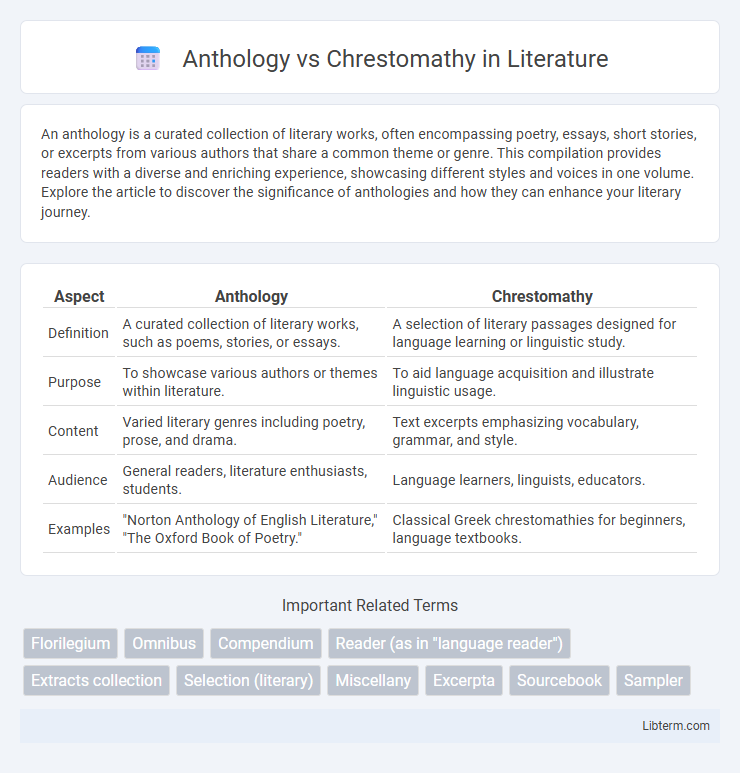An anthology is a curated collection of literary works, often encompassing poetry, essays, short stories, or excerpts from various authors that share a common theme or genre. This compilation provides readers with a diverse and enriching experience, showcasing different styles and voices in one volume. Explore the article to discover the significance of anthologies and how they can enhance your literary journey.
Table of Comparison
| Aspect | Anthology | Chrestomathy |
|---|---|---|
| Definition | A curated collection of literary works, such as poems, stories, or essays. | A selection of literary passages designed for language learning or linguistic study. |
| Purpose | To showcase various authors or themes within literature. | To aid language acquisition and illustrate linguistic usage. |
| Content | Varied literary genres including poetry, prose, and drama. | Text excerpts emphasizing vocabulary, grammar, and style. |
| Audience | General readers, literature enthusiasts, students. | Language learners, linguists, educators. |
| Examples | "Norton Anthology of English Literature," "The Oxford Book of Poetry." | Classical Greek chrestomathies for beginners, language textbooks. |
Understanding Anthology: Definition and Purpose
An anthology is a curated collection of literary works, such as poems, short stories, or essays, selected based on a common theme, genre, or authorial focus to provide readers with a comprehensive overview of a particular subject or style. Its purpose is to showcase diverse voices and perspectives while offering educational value and cultural insight through a thoughtfully organized compilation. Unlike a chrestomathy, which primarily serves as a language-learning tool featuring excerpts for linguistic study, an anthology emphasizes thematic or artistic coherence and literary appreciation.
Chrestomathy Explained: Meaning and Usage
Chrestomathy refers to a curated collection of literary passages or texts used to aid learning and illustrate language usage, often in educational contexts. Unlike an anthology, which assembles works based on theme or author, a chrestomathy emphasizes examples chosen for instructive purposes, such as demonstrating linguistic or stylistic features. It serves as a practical resource for language acquisition, literary study, and historical text analysis.
Historical Origins: Anthology vs Chrestomathy
Anthologies originated in ancient Greece as curated collections of literary works, designed to showcase exemplary texts across genres and authors. Chrestomathies, emerging in the 19th century, served educational purposes by compiling selected texts for language learning and literary analysis, emphasizing practical linguistic utility. Both forms reflect distinct historical functions: anthologies as literary celebration and preservation, chrestomathies as pedagogical tools for mastering language and style.
Key Differences Between Anthology and Chrestomathy
Anthology and chrestomathy both compile selected literary excerpts, but an anthology prioritizes a diverse range of works chosen for artistic or thematic value, often from multiple authors and genres. A chrestomathy is specifically curated for educational purposes, focusing on exemplary texts that illustrate language, style, or historical development with extensive annotations. The primary distinction lies in their intent: anthologies aim for broad literary appreciation, while chrestomathies serve as instructional tools with didactic commentary.
Types of Works Included in Anthologies
Anthologies typically feature a curated collection of literary works, such as poems, short stories, essays, and excerpts from longer texts, representing various authors or themes. They often emphasize thematic coherence or genre-specific selections, including classical literature, contemporary writings, and culturally significant works. Unlike chrestomathies, which prioritize educational or linguistic purposes with examples illustrating language use, anthologies focus on showcasing artistic diversity and literary merit.
Chrestomathy: Focus on Linguistic and Educational Value
Chrestomathy offers significant linguistic and educational value by compiling selected passages that illustrate language usage, grammar, and stylistic features, making it an essential tool for language learners and scholars. Unlike a general anthology, which collects various literary works primarily for aesthetic appreciation, a chrestomathy emphasizes practical learning through curated texts that demonstrate linguistic patterns and cultural context. Its structured approach aids in language acquisition, historical linguistics research, and the preservation of textual heritage.
Popular Examples of Anthologies
Popular examples of anthologies include the "Norton Anthology of English Literature," which compiles significant works from various authors and eras, and the "Best American Short Stories" series, highlighting top contemporary fiction. Anthologies curate a diverse range of writings, contrasting with chrestomathies that focus more on educational texts for language or literature learning. Collections like "The Oxford Book of American Poetry" also exemplify anthologies by assembling representative samples of a particular genre or period.
Notable Chrestomathies in Literature
Notable chrestomathies in literature, such as Max Muller's "Chrestomathia Sanscritica," provide carefully curated selections designed to aid language learning and literary analysis, distinguishing them from general anthologies. These chrestomathies emphasize educational value by including annotated texts that highlight linguistic features and cultural context, enhancing readers' comprehension of classical and foreign languages. Collections like "The Anglo-Saxon Chrestomathy" by Henry Sweet have become essential resources for scholars seeking systematic study through representative passages rather than random excerpts.
Choosing Between Anthology and Chrestomathy
Choosing between an anthology and a chrestomathy depends on the purpose of literary study or collection; anthologies compile diverse works to showcase a broad range of styles, genres, or themes, while chrestomathies focus on exemplary texts designed for learning language or literature through closely selected passages. Researchers or students aiming for comprehensive exposure benefit from anthologies, whereas those seeking structured linguistic or stylistic training prefer chrestomathies for their curated content. The decision hinges on whether the goal is to explore breadth or deepen understanding through curated, pedagogical selections.
The Modern Relevance of Anthologies and Chrestomathies
Anthologies and chrestomathies serve distinct but complementary roles in literary education and cultural preservation, with anthologies offering curated selections of works to highlight thematic or genre-based insights, while chrestomathies compile texts primarily for language learning and historical study. The modern relevance of anthologies lies in their ability to showcase diverse voices and contemporary issues, enriching literary discourse and offering accessible entry points for new readers. Chrestomathies maintain importance in academic settings by providing context-rich material essential for linguistic proficiency and deeper understanding of classical literature and evolving language patterns.
Anthology Infographic

 libterm.com
libterm.com